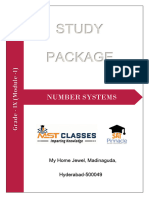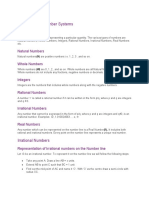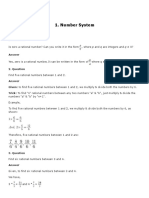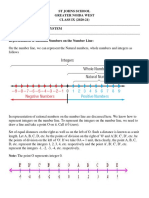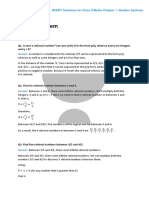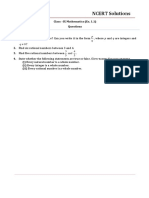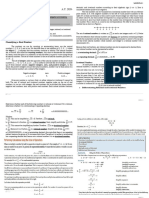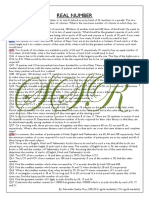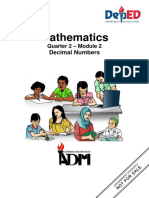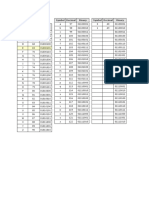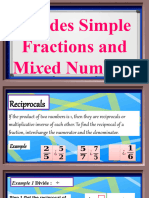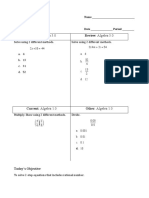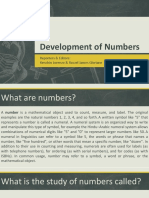Mathematics – IX Telegram channel by Richa Ma’am: Ecomathsclass09
Chapter-1
Number Systems
Introduction:
Real Numbers
All the rational and irrational numbers make up the collection of real numbers.
Introduction
We are familiar with the number systems such as:
I or Z = set of Integers = {….-3,-2,-1, 0, 1, 2, 3,}
Q = set of rational numbers = {p/q Ι p, q ∈ I and q ≠ 0)
The relationship of these sets of numbers can be pictorially represented as shown below:
1. Rational numbers are numbers that can be expressed in the form p/q, where q is a non-zero integer and p is
any integer.
2. Irrational numbers are numbers that cannot be put in the form p/q where q ≠0, p, q ∈ I. For example
√2 , √3, √6 .
3. Every integer is a rational number but a rational number need not be an integer.
4. Every fraction is a rational number but a rational number need not be fraction.
5. A rational number p/q is said to be in the standard form if q is positive integer and integer’s p & q have no
common divisor other than 1.
𝑥+𝑦
6. Between two rational numbers x and y, there is a rational numbers . We can find as many rational
2
numbers between as we want.
7. If x and y are any two rational numbers, then:
x + y is a rational number.
x - y is a rational number.
x × y is a rational number.
x ÷ y is a rational number (y ≠ 0)
8. If x and y are any two irrational numbers, then:
√5 + √5 = 2√5 (irrational + irrational = irrational)
√5 – √5 = 0 (irrational - irrational = rational)
√5 × √5 = 5 (irrational × irrational = rational)
√5
9. = 15 (irrational ÷ irrational = rational)
√5
�Mathematics – IX Telegram channel by Richa Ma’am: Ecomathsclass09
10. Every rational number can be expressed as a decimal.
11. The decimal representation of a rational number is terminating or non- terminating (repeating) decimal.
3/5 = 0.6 (Terminating)
6/7 = 0857142857142 (Repeating)
9/11 = 0.81 (Repeating)
5/8 = 0.625 (Terminating)
12. The decimal expansion of an irrational number is non-terminating non-recurring. Moreover, a number
whose decimal expansion is non-terminating non-recurring is irrational.
13. If the denominator of a rational number written in standard form contains no prime factors other than 2 or 5
or both, then it can be represented as a terminating decimal.
14. If the denominator of a rational number written in standard form contains has prime factors other than 2 or
5, then it cannot be represented as a terminating decimal.
15. A number in the terminating decimal form can be converted to one in the rational form by summing the
place values of all the digits.
16. A number in the recurring decimal can be converted to one in the rational form by multiplying the decimal
by a suitable power of 10 and eliminating the decimal point.
17. A useful result to convert a number in the recurring decimal form to the rational form:
If all the digits on the right side of the decimal part are repeated, then
Given decimal = Integral part of the decimal number +
Number formed by the digits in decimal part
Number formed by the same number of 9′ s as the number of digits in the decimal part
7 7 49 4
For ex. 0.7 = 0 + 9 = 9 , 2.49 = 2 + 99 , 5.04 = 5 + 99 etc.
18. Geometrical Representation of Irrational Numbers
Every rational number has a unique position on the number line.
19. But does every point on the number line represent a rational number?
�Mathematics – IX Telegram channel by Richa Ma’am: Ecomathsclass09
To verify let us draw a number line.
According to Pythagoras theorem,
OB 2 = OA 2 + AB 2
= 12 +12
=1+1
=2
OB = √2,
With O as center, OB as radius, draw an arc cutting the number line at P. OB =OP = √2
Hence point P presents √2 on the number line. (√2 is irrational).
There are many points on the number line which are irrational.
Thus, we have learnt that every irrational number can be represented on the number line.
This method is recalled here through the diagram.
Accuracy of this representation depends on the accuracy of construction.
20. If r is rational and s is irrational, then r + s and r – s are irrational numbers, and r×s and
r ÷ s are irrational numbers, r ≠ 0.
21. For positive real numbers a and b, the following identities hold:
𝑎 √𝑎
(i) √𝑎𝑏 = √𝑎√𝑏 (ii)√𝑏 = (iii) √𝑎 + √𝑏 √𝑎- √𝑏 = 𝑎 – b (iv) 𝑎 + √𝑏 𝑎 - √𝑏= 𝑎 2- b
√𝑏
(v) √𝑎 +√𝑏 2
= 𝑎 + 2√𝑎𝑏 + b (vi) √𝑎 +√𝑏 √𝑟 +√𝑠 = √𝑎𝑟 +√𝑎𝑠 √𝑏𝑟 +√𝑏𝑠
1 √𝑎−𝑏
22. To rationalise the denominator of , we multiply this by , where a and b are integers.
√𝑎+𝑏 √𝑎−𝑏
23. Let a > 0 be a real number and p and q be rational numbers. Then
𝑎𝑝
(i) 𝑎𝑝 × 𝑎𝑞 = 𝑎𝑝+𝑞 (ii) (𝑎𝑝 )𝑞 = 𝑎𝑝×𝑞 (iii) = 𝑎𝑝−𝑞 (iv) 𝑎𝑝 × 𝑏 𝑝 = (𝑎 × 𝑏)𝑝
𝑎𝑞
1
(v) 𝑎0 = 1 (vi) 𝑎1 = 𝑎 (vii) 𝑎𝑛 = 𝑎−𝑛
24. Let a > 0 be a real number and n a positive integer. Then √𝑎 = b, if bn = a and b 0.
𝑛
Real Numbers
Integers Decimal
Neither +ve nor -Ve
Negative integers Positive integers Terminating Non-terminating
Interger
Ex.-1,-2,-3…... 0 Ex.1,2,3…... 0.825 Repeating Non-Repeating
0.7582 0.22222222 0.101001
0.1225 0.148484848 0.55055505
0.142142142 π
NO NEED TO PURCHASE ANY BOOKS
For session 2020-2021 free pdf will be available at Channel Link -
https://www.youtube.com/ecomathsclass09&10.
Telegram- https://t.me/ecomaths
File Revision Date: 15th March 2020










